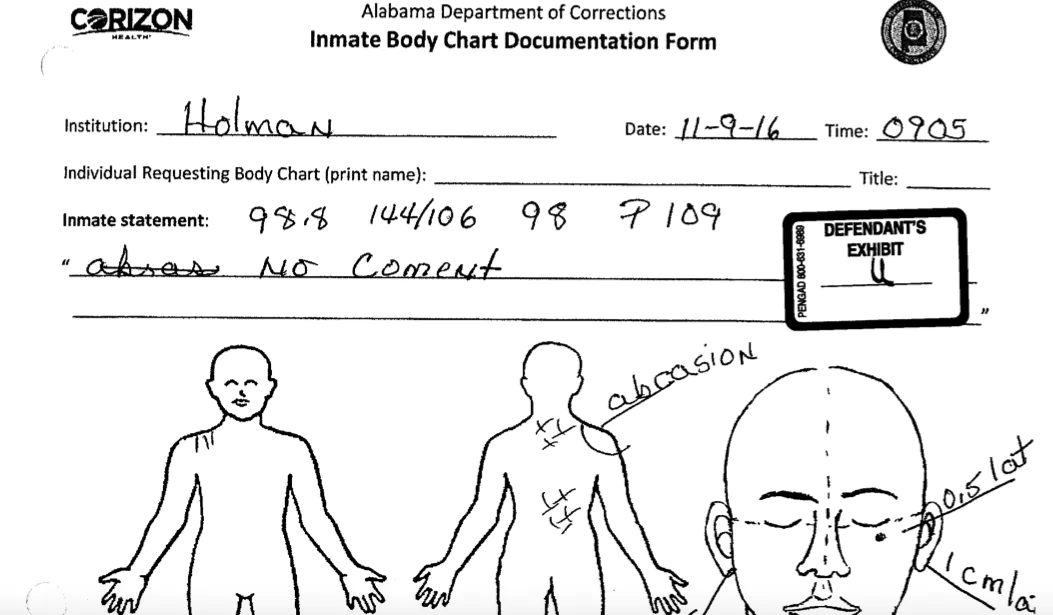At 6:35 A.M. on the morning of Nov. 9, 2016, approximately 39 correctional officers wearing riot gear, some carrying firearms, entered the Bravo dormitory at the Holman Correctional facility near Atmore.
What happened in the moments that followed resulted in 16 civil lawsuits filed by incarcerated men who say officers used batons and fists on already-handcuffed men, refused medical care for some and warned men not to discuss what happened with prison medical staff. Hospital records indicate a collapsed lung, multiple broken ribs, cuts and bruises among the incarcerated men’s injuries.
Correctional officers and prison administrators say officers used only enough force to get the men in handcuffs that morning, that no one was beaten after being secured and everyone was given proper medical care, according to multiple affidavits by officers, administrators and prison medical staff in court records.
Those records show that correctional officers say an event at Holman prison two days prior left officers fearful for their lives, and that the raid was needed to collect contraband weapons and arrest suspects in that previous incident.
The raid and lawsuits that followed come as the ADOC continues to struggle with prison overcrowding, too few correctional officers and a culture of violence. It’s a recipe that’s resulted in a prison homicide rate of more than nine times the national average and all-too-common suspected drug overdoses of incarcerated men.
In February, five of those lawsuits will head into settlement conferences in front of federal judges in Mobile, where the plaintiffs and attorneys for Alabama Department of Corrections (ADOC) will make their cases before possible jury trials.
A man serving in an Alabama prison who was in the Holman dormitory for both of those incidents in November 2016, told APR by phone from prison that the incarcerated men believe the raid was payback, meant to establish fear by assaulting those considered to be the most vocal. The man asked not to be identified because he said he fears prison staff may retaliate for speaking to a reporter. APR has confirmed the man’s identity and that he was in Holman at the time of the Nov. 7 and Nov. 9 incidents.
“A few inmates did get a little rowdy,” the man said, speaking of the incident on Nov 7, 2016.“Mainly about the tents around the dorm, but it got settled…the officers were in the right. The inmates were wrong.”
Court records show that on Nov. 7, 2016, Correctional Emergency Response Team (CERT) officers entered the prison and began removing clotheslines that had been strung around beds, which the men used as makeshift “tents.” One officer broke a man’s broom handle in the process, which caused a reaction from the men.
“When the approximately 114 inmates inside B-Dorm observed this they all rose up off their beds and began shouting obscenities and threatening us,” said ADOC Sergeant Jesse Wilson in an affidavit. “Numerous inmates made death threats to us and were making statements such as “We run this bitch!”…Several inmates were observed with knives and broomsticks in their hands to be utilized as weapons.”
Wilson said that officers were in the dorm for about five minutes “attempting to talk our way out. We were outnumbered with approximately 1l4 inmates and only approximately 10 officers. I have never been so afraid for my life like I was during this uprising. Thankfully, we were able to exit the dorm safely.”
“There had been increasingly less control over B-dormitory due to the lack of staff and manpower and the very real concern about confronting the dangerous inmates concentrated in that area,” said ADOC Sergeant Harry Finklea in an affidavit.
Two days later, around 39 officers with the North Central, South Central and Southern Region CERT teams entered Holman with a list of 19 names, men who had been identified as having been “armed and aggressive” in the Nov. 7 incident.
An internal investigation of the Nov. 9 incident by ADOC Investigations and Intelligence Division investigator David Jones found that officers “acted in accordance with the policies and procedures of the Alabama Department of Corrections” because the “apparent threat was visible to the South CERT team with inmates possessing knives and ice picks seen on Nov. 7.”
“The injuries sustained by the inmates were minimal based on the Medical Assessment completed by the Health Care Staff on Nov. 9, 2016,” Jones wrote in his report. According to court records 30 prison-made knives were recovered during the Nov. 9 incident.
“They came in swinging sticks and screaming and hollering. It felt like war,” the man serving at Holman prison told APR. “They were screaming ‘everybody lay down’ and as they were saying this they were just beating people. They were just swinging their sticks hitting people.”
The man said that before officers entered there was “nothing going on” in the dormitory, the men were sleeping, he said, and the area was under control of the guards. Numerous statements by ADOC officers in court records say they were responding that morning to an ‘active disturbance.”
“They were just mad. They were dealing with pride, so they went and got their whole group,” he said. “I was looking around and they were hitting old people, young people. It didn’t matter. They hit a guy in a wheelchair.”
Below is information on a few of the 16 lawsuits, ten of which remain active.
(One plaintiff dropped his lawsuit after becoming a Christian and wanting to forgive, he wrote to the court. Another case was dismissed after the man was released and the court was unable to reach him.
Moses Robinson, who filed suit on Feb. 7, 2017, died on Dec. 30, 2019, after being assaulted by another incarcerated man at Holman. Three lawsuits were dismissed for failure to pay filing fees, which ranged from $1.50 to $400 in each case.)
Jimmy Stanton
Among the men who filed lawsuits after the Nov. 9, 2016, incident is Jimmy Stanton, who is serving life without parole at Holman for murder.
In his complaint Stanton said that when officers entered he was almost immediately handcuffed with plastic cuffs behind his back and “made to stand beside to C.E.R.T. members and slapped by a third, who was told by another officer to do so and to throw me on the floor, in front of my bed with numerous other inmates bunched together tightly.”
“They then actually stepped on and walked back as though we were a carpet rug…Then after a long length of time I was picked up and placed on top of another inmate in a homosexual position as C.E.R.T. members watched a laughed…we refrained from saying anything about it, afraid we would be beat further.”
Stanton said in his complaint that he was then taken to the showers because he had urinated on himself in his wheelchair and that “it was one of the most scariest days of my confinement; cause I was unable to walk, and at the complete mercy of the C.E.R.T. team.”
Medical records show that not long before the Nov. 9 incident Stanton had surgery on his back and his neck and was given a wheelchair.
Correctional officers in affidavits told the court that no one used force on Stanton on the morning of Nov. 9 and that he was not listed as a suspect in the Nov. 7 incident.
“Furthermore, due to inmate Stanton’s physical condition, (which was the result of recent surgery on the nerves in his neck) it was determined that Stanton was not an immediate threat to the CERT team’s operation on November 9, 2016,” Alabama Attorney General Steve Marshall wrote to the court in an Oct. 11, 2017, filing.
Stanton, who is representing himself, told the court in a Jan. 8, 2020 filing that it was correctional officer David Dennis who hit Stanton in the face on Nov. 9 and that Lieutenant Dominic Whitley was present when he was hit and afterward Whitley lifted Stanton up to turn him over and place handcuffs on him.
Correctional officer Dennis and Lieutenant Whitley in signed affidavits both wrote that on the morning of Nov. 9 both saw an “unknown inmate” standing up and both used force to get the inmate to lay on the bed and into handcuffs.
Although Stanton is not listed as one of the 19 men on a “duty officer report” filed on Nov. 9, which states those men failed to comply with officers’ orders that morning and that “The CERT Teams used force on the above mentioned inmates to get them to comply with the orders given,” Stanton’s name does show up on a separate document.
An “incident report” later completed by warden William Streeter does list Stanton as one of a total of 33 men whom officers used force on that morning, but Streeter later told the court that Stanton’s inclusion on that second list was due to “poor proofing.”
Warden William Streeter in his affidavit wrote that on Nov. 9 he saw Stanton seated in his wheelchair.
“Inmate Jimmy Stanton refused the orders given and remained seated in his wheelchair. Inmate Stanton, in fact, made no effort to move from his wheelchair to his bed. Therefore, inmate Stanton, along with others who refused to obey those direct orders, were written up. That is the only reason inmate Stanton’s name was included in the incident report, which I prepared,” Streeter said in the court filing. “As noted, no physical force of any kind was used on inmate Stanton. Any indication whatsoever to the contrary was merely inadvertent and poor proofing on my part. Disciplinary action was later initiated against inmate Stanton for Failure to obey a direct order of an ADOC employee.”
Leon Carmichael Jr.
Leon Charmichael Jr. is serving life without the possibility of parole for a 2009 capital murder conviction. Carmichael’s lawsuit is set for a settlement conference on Feb. 11 in U.S. Magistrate Judge Sonja Bivens’s courtroom.
“All I could hear was inmates being jumped on and screaming. After about ten (10) minutes a riot team (CERT team) officer said “The Cert team will not be disrespected!,” Carmichael wrote in his complaint. “…After that the riot team (cert team) officers started singling out inmates throughout the dorm and jumping on them….Warden/cert team officer Streeter was calling out names and every inmates name that he called out the riot team (cert team) officers unmercifully jumped on them.”
Carmichael said an officer came to his bed and ordered him to put his hands behind his back, which he did, and was handcuffed with plastic ties. Streeter continued to call out names and officers continued to “jump on” those men for another 10 minutes or so, Carmichael said in the court filing.
Carmichael said his name was called and “a white officer grabbed me by the arm, pulled me off the bed and slammed me on the floor. I was immediately punched in the face, stomped, kicked and poked in my back and the back of my leg with a riot baton.”
He was then walked to the front of the dorm where he says CERT officer Nathan McQuirter asked another officer to hold Carmichael up, he said in his complaint.
“The white riot team officer (cert team) officer hooked both of his arms (sic) threw mine from behind and picked me up on my tip toes and officer McQuieter speared me in my chest, my ribs with his riot baton. I was again slammed to the floor, punched, slapped, kicked, and poked in the back and leg with riot batons.Again someone said “Alright!! Alright!! That’s enough!,” Carmichael wrote, adding that he was then taken to a bathroom area where other inmates who had been beaten had been placed by guards.
“About 20 minutes later I was taken to the infirmary. On the way there a riot team (cert team) officer told me, “Don’t say shit unless asked a question. Keep your (expletive) mouth shut. Answer the nurse and that’s it. Say anything and that’s your ass!,” Charmichael wrote.
Carmichael said that the nurse asked for his name and inmate number, took his blood pressure and temperature and “Without even looking at me or examining me she said ‘Okay. He can go.’ I started to tell her that I couldn’t breathe and the riot team (Cert team) officer slapped me in the mouth, busted my lip and said ‘(Expletive) Didn’t I tell you to shut the (expletive) up? The nurse said you can go. Say something else and I’m going to (expletive) you up.’ I was taken from the infirmary and never examined for injuries.”
A body chart form filled out by a nurse at 9 a.m. on Nov. 9, 2016, notes Charmichael made “no statement” and the nurse noted “no markings” on his body. He was then placed in a segregation cell, Carmichael said in the filing.
“I also told them that I could not breathe, I could barely walk or stand up and that I was in pain,” he wrote.
Carmichael said each day he filled at a sick call slip, but was never taken to the infirmary, despite telling the nurse, officers and warden Terry Raybon that he couldn’t breathe.
The day before Thanksgiving an officer asked him if he wanted to go to sick call, and Carmichael said yes, writing that once there, two nurses “saw the extent of my injuries and asked me how did it happen. I told them and they asked me had I been in the condition I was in since Nov. 9 and I said yes.”
Carmichael wrote that he was immediately sent to the infirmary, where a doctor asked if he’d been in that condition since Nov. 9, and that he said “yes.”
The doctor had x-rays done of Charmichael’s legs and ribs and after reviewing the results called his supervisor and told him to take Carmichael to an emergency room at a hospital outside of the prison immediately, Charmichael wrote in his complaint.
Medical records show that Carmichael arrived at Atmore Community Hospital on Nov. 23 at 7:37 p.m. and examined by Dr. Elizabeth Bataglia. According to his complaint Carmichael said two correctional officers took him to the hospital.
Dr. Bataglia diagnosed Charmichael with bruising on the lower leg and multiple rib fractures.
In those medical records Dr. Bataglia notes Carmichael as the possible victim of a sexual assault, and that his history was provided to her by the patient “and other. The history is limited by other.”
“The incident occurred more than 1 week ago. Sexual partner: Hit in jail by a guard. Context: ln Prison hit with a baton,” Dr. Bataglia notes in the medical records.
It’s unclear from those records records who the “other” is who provided information to the doctor about Carmichael having allegedly been sexually assaulted and injured as a result, but the medical records show no such signs of a sexual assault, only multiple broken ribs and injuries to his legs, and Charmichael told a nurse hadn’t been sexually assaulted.
On a separate patient screening form under a listing titled “patient observations” nurse Wanda Riley noted “abuse denied by patient” and initialed that entry “WR”.
According to his complaint Carmichael had been kept in solitary confinement from just after the Nov. 9 incident until he was taken to Atmore Community Hospital.
Assistant Attorney General Betty Carmack on Sept. 21, 2017, asked the court to release Carmichael’s medical records from the Atmore hospital, and in the filing Carmack alleges that Carmichael’s injuries were the result of a sexual assault, and not related to the Nov. 9 incident with correctional officers.
“Upon a preliminary review of the plaintiff’s medical records from the Alabama Department of Corrections, counsel was alerted to a hospital visit by the plaintiff on November 23, 2016 for assault. Said assault was by a sexual partner and may explain any injuries the plaintiff alleges were caused by the defendants,” Carmack wrote.
In a court filing on Nov. 15, 2019, Assistant Attorney General Bettie Carmack told the court that an x-ray taken at the prison on Nov. 23, 2016, indicates that Carmichael’s ribs were normal, and that “it would seem that Inmate Carmichael may have incurred his injuries after being raped by another prison inmate sometime during the month of November of 2016.”
However, X-rays taken later that same day, Nov. 23, 2016, at the Atmore Community Hospital show Charmichael had multiple rib fractures, according to the medical records.
A ADOC spokeswoman cited the ongoing litigation when declining to answer APR’s questions about the discrepancies between the X-ray taken at the prison and the x-ray done by hospital staff that same day.
“I NEVER did anything for this to happen to me. I was also given two (2) disciplinaries and never taken to disciplinary court on either of them. I asked Warden Rayborn why I was assaulted when he came to segregation with the segregation review board and he told me that sometimes it’s just best for me to keep my mouth closed…I was assaulted, denied medical treatment for 2 weeks and placed in segregation for no reason what so ever,” Charmichael wrote.
Assistant Attorney General Bettie Carmack in the Nov 15, 2019, court filing wrote that on Nov. 9 “Inmate Carmichael became combative” and force was used to “maintain order or restore discipline.”
Charmichael was charged with having a weapon, gathering in a threatening manner and disobeying an order, charges he was later found not guilty of because he didn’t receive a hearing within ADOC’s prescribed time frame, records show.
None of the incarcerated men who were charged with those same infractions connected to the Nov. 7 and Nov. 9 incidents and who filed lawsuits against ADOC were allowed hearings in which witnesses could have been called to clear them of those charges.
Instead, prison administrators held many of them in segregation cells, waited beyond the required 10-day time limit to hold those heartings and found them “not guilty” court records show.
A “duty officer report” filed on Nov. 9, 2016, lists 19 incarcerated men as having failed to obey orders, having weapons and threatening officers.
An “incident report” filed on Dec. 12, 2016, however, lists 33 men who were arrested during the Nov. 9 incident, and states that “The CERT Teams used force to include impact weapons and physical force on the above mentioned inmates to get them to comply with the orders given.”
Quandarian Faulkner
Quandarian Faulkner alleges in his complaint that on the morning of Nov. 9 four or five CERT team officers came to his bed and “hit me with a stick and told me to get out of bed and don’t look at them. I was beaten all the way to the bathroom, and was told to 1ay down on the floor face down in handcuffs where other inmates were being beaten and hollering.”
Faulkner alleges that he was taken to the healthcare unit in the prison but was refused medical treatment, “and the riot team members took me back to B-dorm and continued to beat me and call me derogatory names, I was asking other officers that was standing around for help, and heard some of them say (expletive) you, you didn’t ask for help Monday.”
“After they finished beating the inmates me and several other inmates that was beaten unconscious were taken to segregation, where I laid up in a cell beggin for help, I felt like I was dying I was in so much pain, I could not breathe,” Faulkner said in his complaint.
“I wrote letters to the Warden, captain asking for help. The I.C.S. officer came back there and I begged him to please get me some help because I could not breathe, finally two cert team members came and took me to health care where I was told by the nurses that my body was not breathing on the left side, the doctor told me that I needed free world help immediately that they couldn’t determine what was going on inside of me, I was taken to the free world hospital where they immediately stuck a chest tube inside me”
According to a “review of segregation inmates” form in court records, Faulkner was placed in segregation on Nov. 9, 2016, and was still there until at least March 9, 2017.
A nurse at the prison completed a body chart for Faulkner on Nov. 9 at 8:30 a.m. and noted no injuries and that his lungs were “clear, bilateral” and that Faulkner stated “my ass hurts.”
On Nov. 10, 2016, a nurse at the prison noted that Faulkner complained of chest pain and told her “I got whooped,” according to medical records.
That same day he was sent to Atmore Community Hospital then transferred to the Mobile Infirmary and diagnosed with a collapsed lung, according to medical records. A nurse noted that Faulkner complained of chest pain and said it happened “following an altercation on 11/9/16.”
In an affidavit Holman prison warden William Streeter wrote that Faulkner was one of the men who on Nov. 7 had communicated “intent to inflict harm to staff with a weapon” and “was armed with a knife and part of the group that circled CERT team members in a threatening manner on November 7, 2016”
“He also appeared to take a leadership role in inciting other inmates to act out against the CERT team that day,” Streeter said of Faulkner.
Brandon Washington
Brandon Washington says when officers entered the dormitory on Nov. 9 he watched as they began using batons on men who were lying in their beds, according to his complaint.
Washington, who is serving a life sentence for a 2006 murder conviction, said when officers got to him he was struck in the back with a baton while laying on his bed and then handcuffed.
Officers then began calling out the names, and he watched as CERT officers went to those men and began attacking them, Washington’s complaint states.
“The CERT members weren’t wildly swinging the sticks, it’s like they were trying to push the butt end of the sticks into the sides, back, legs (anywhere soft) being careful to avoid the heads of inmates,” Washington said in the court filing.
When his name was called Washington said he didn’t respond, but that an officer located him.
“The sticks began to crash and slam into my body, pain erupted from my ribs, spine, legs, and arms,” Washington wrote, adding that one officer noticed he was having a hard time breathing and dumped a nearby ice chest filled with ice-water onto Washington.
“My body was hot and in pain and his attempt to make me suffer more, actually brought a welcomed relief to my body,” he wrote.
Washington said he was soon taken to the restroom where he saw “multiple inmates laying on the floor in the bathroom, arms tied and their bodies (sic) throwed across each other …Suddenly I was kicked in the back and fell forward only to fall on top of the other inmates.”
“I laid there trying to find a comfortable position on top of all the bodies only to be kicked in the mouth by a CERT member and told to be still,” Washington said in the complaint.
On a body chart form filled out on Nov. 9, 2016, at 9 a.m. a nurse noted that Washington told her “ribs sore” and recorded a 2 centimeter cut to his rib area.
Records show Washington wasn’t charged with possessing a weapon in the Nov. 9 incident until April 18, 2017, more than two months after he filed his lawsuit, on Feb. 9, 2017. Washington was found not guilty of that charge on April 26, 2017, according to those records, because “the disciplinary was not served in the prescribed time frame.”
ADOC declined to answer questions about why some were not charged with possessing weapons in the Nov. 9 incident until much later, in some cases even after lawsuits were filed.
Phillip Hill
Phillip Hill, 34, of Anniston is serving 15 years for 2016 convictions on domestic violence, breaking and entering a vehicle and receiving stolen property, according to court records.
Hill’s complaint states that he was asleep when officers entered the dorm on Nov. 9 and was awakened by a CERT officer slapping him in the face.
“…I was repeatedly hit with sticks in the ribs and back then I was drugged up the floor and thrown on top of inmate Timothy Maulet where I kicked in the ear causing a busted ear drum which I still have hearing damage because of,” Hill wrote in his complaint.
Hill states he was then taken to receive medical attention, and that after officers realized Hill wasn’t the person they were looking for he was uncufed and sent back to the dormitory.
Prison medical records written by a nurse at 9:05 a.m. on Nov. 9, 2016, notes Hill had “no comment” and had abrasions on his right shoulder, neck and back, a small cut under his left eye, and an injury to his left ear.
On Nov. 10, 2016, a sick call request form notes that Hill told medical staff “was assaulted my members of ADOC cert team. Ear drum is busted. No hearing out of left ear and it continues to leak blood. Ribs are sore and was told by medical personnel that at least two are broken.”
In a statement to APR on Thursday morning ADOC spokeswoman Samantha Banks described steps the department has taken to curb use of force incidents in recent years.
“While this alleged incident occurred many years ago, significantly reducing use of force incidents within the ADOC continues to be a top priority for the Department,” the statement reads. “In December 2019, Commissioner Jeff Dunn announced the formation of a new internal task force, “Tactics and Techniques” reinforcement training programs, health and wellness interventions for correctional officers and staff, additional inmate rehabilitation programs and resources assisted by a Community Support Network, and the reexamination of enhanced surveillance measures such as the possible use of body cameras by on-duty correctional officers. Due to ongoing litigation, ADOC is unable to provide comment on the specifics of this matter.”
Speaking to APR from prison, the man who asked not to be identified said that, contrary to statements by CERT officers and prison officials, the incarcerated men on the morning of Nov. 9 weren’t defying orders.
“No inmate is going to be rowdy when you come in with guns,” he said.
“I did something in my life to come here. I did, but I didn’t think people are like this. How can you not see what your doing to us?,” he said. “They are creating monsters. Not only are they creating monsters in inmates. They’re creating monsters in guards. I don’t trust none of them now.”


















































